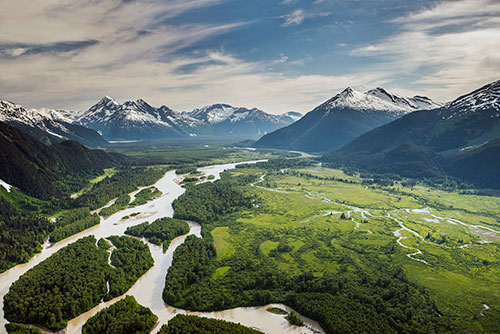|
Fish Factor Southeast’s largest and most productive wild salmon rivers at riskBy ELAINE O'BRIEN October 25, 2014
That is the situation in Southeast Alaska, where residents find themselves downstream from several massive open pit gold/copper mines being developed in bordering British Columbia. The mines are located in the headwaters of some of Southeast’s largest and most productive wild salmon rivers: the Taku, Stikine, and Unuk.
Transboundary watersheds, Taku river ...
“Right now the U.S. and certainly Alaska have no say in how these watersheds we share with Canada are developed,” said Heather Hardcastle, Trans-boundary Rivers Campaign Director for Trout Unlimited, and co-owner of Taku River Reds in Juneau.
“And that is primarily by writing letters to our Congressional Delegation and the State Department, as well as urging law makers, municipalities, advisory committees, boards and commissions and businesses to send similar letters. “What we are asking is for the U.S. State Department to engage with Canada on this matter, and activate the Boundary Waters Treaty,” said Hardcastle who has teamed with Salmon Beyond Borders and the United Tribal Transboundary Mining Working Group in the grass roots outreach efforts. An International Joint Commission (IJC) was created by the Boundary Waters Treaty of 1909 to prevent and resolve transboundary water disputes between Canada and the U.S. “We feel that the best mechanism by which we can have a say in the Taku, Stine and Unuk watersheds is to have the IJC activated and review these watersheds and the development that Canada is proposing and constructing even as we speak,” Hardcastle added. Both the US and Canadian federal governments must “refer an issue” to activate the joint commission. “The first step is convincing the U.S. State Department that they should look at this matter,” Hardcastle said, “and then to continue building ties across the border to similarly urge Canadians to push for the same thing.” Alaska’s Congressional Delegation has come out strongly in support of the IJC oversight. Is Canada receptive? The short answer, she said, is no. “When it comes to the Canadian federal government and the BC provincial government, their agenda is mineral development,” Hardcastle said. “They have not reached out to Alaskans in any meaningful way.” Be a seafood ambassador A call is out for fishermen who want to be unofficial ambassadors for Alaska seafood. A big challenge, he added, is how to stay connected with the fishing fleet. “There’s a lot of times when individual retailers or media outlets are looking for folks to talk with who are involved in the fisheries in Alaska, and this offers a great tool to help fishermen get out there,” Fick said. “So when we have press tours or trade missions or events around the state or the country, we have this wealth of knowledge and individuals to call on to advance our Alaska brand and maximize the value.” Sign ups get a custom Alaska Fisherman hat from the Aurora Projekt. Find the data base at www.fishermen.alaskaseafood.org/ Wholesale prices for Alaska salmon products were down nearly across the board this summer compared to the same time last year. Every four months Alaska processors provide price reports to the Dept. of Revenue/Tax Division on how much they sold fresh or frozen salmon, fillets, roe and canned products at wholesale by Alaska region. Here are some highlights on sales from May through August: By far most of Alaska’s salmon pack goes out headed and gutted (H&G) and frozen. Chinook salmon in that form fetched $3.95 a pound, down from $4.51 last summer. Sockeye at $3.14 was a drop of $1.07 per pound. Cohos wholesaled for $2.91, compared to $3.60. The price for H&G frozen pink salmon increased a quarter to $1.28; chums saw the biggest gain at $1.54, a 45-cent increase. All Alaska salmon prices decreased for fresh fish during the summer, with H&G sockeyes averaging $4.43 per pound, down 66-cents from the same time last year. Processors produced four million pounds of fresh sockeye fillets valued at $8.80 a pound, a drop of 48 cents. Prices for fresh coho fillets also declined to $6.63, down $1.56. Likewise, chum fillets at $2.19 were down $1.19 a pound from last summer. Fall is an important sales period and wholesale seafood prices are likely to reflect changes from the summer. Find links to the Alaska Salmon Price Reports at www.alaskafishradio.com/
This year marks the 24th year for this weekly column that focuses on Alaska’s seafood industry. It began in 1991 in the Anchorage Daily News, and now appears in over 20 newspapers and web sites. A daily spin off – Fish Radio – airs weekdays on 30 radio stations in Alaska. My goal is to make all people aware of the economic, social and cultural importance of Alaska’s fishing industry to our state, the nation and the world. Laine Welch ©2014 www.alaskafishradio.com SitNews ©2014 Stories In The News Ketchikan, Alaska
|
||

